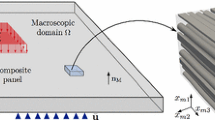Abstract
We present a parametric model for generating unit cells with randomly distributed inclusions. The proposed algorithm possesses (1) robustness by yielding unit cells with fiber volume fraction of up to 45 % for aspect ratios as high as 20, (2) computationally efficiency accomplished through a hierarchy of algorithms with increasing computational complexity, and (3) versatility by generating unit cells with different inclusion shapes. A statistical study aimed at determining the effective size of the unit cell is conducted. The method has been applied to various random inclusion microstructure composites, including: (1) two-dimensional chopped tow composites employed in automotive applications, (2) polyurea or polyethene coating consisting of hard and soft domains (segments) employed for energy absorption in military and industrial applications, and (3) fiber framework called fiberform embedded in or free from an amorphous matrix used as heat shield on space crafts to prevent structural damage during reentry into the atmosphere.

























Similar content being viewed by others
References
Wentorf R, Collar R, Shephard MS, Fish J (1999) Automated modeling for complex woven mesostructures. Comput Meth Appl Mech Eng 172(1):273–291
Gusev AA (1997) Representative volume element size for elastic composites: a numerical study. J Mechan Phys Solids 45:1449–1459
Gusev AA, Heggli M, Lusti HR, Hine PJ (2002) Orientation averaging for stiffness and thermal expansion of short fiber composites. Adv Eng Mater 4(12):931–933
Duschlbauer D, Bohm HJ, Pettermann HE (2006) Computational simulation of composites reinforced by planar random fibers: homogenization and localization by unit cell and mean field approaches. J Compos Mater 40(24):2217–2234
Widom B (1966) randomsequential adition of hard spheres to a volume. J Chem Phys 44(10):3888–3894
Bohm HJ, Eckschlager A, Han W (2002) Multinclusion unit cell models for metal matrix composites with randomly oriented discontinuous reinforcements. Comput Mater Sci 25:42–53
Torquato SHH (2002) Random heterogeneous materials: microstructure and macroscopic properties. Appl Mechan Rev 55(4):B62
Williams SR, Philipse AP (2003) Random packing of spheres and spherocylinders simulated by mechanical contraction. Phys Rev E 67:051301-1-9
Tu ST, Cai WZ, Yin Y, Ling X (2005) Numerical simulationof saturation behavior of physical properties in composites with randomlyu distributed second phase. J Compos Mater 39(7):631–671
Kari S, Berger H, Gabbert U (2007) Numerical evaluation of effective material properties of randomly distributed short cylindrical fiber composites. Comput Mater Sci 39:198–204
Pan Y, Iorga L, Pelegri AA (2008) Numerical generation of a random chopped fiber composite RVE and its elastic properties. Compos Sci Technol 68:2792–2798
Toll S (1998) Packing mechanics of fiber reinforcements. Polym Eng Sci 38(18):1337–1350
Lubachevsky BD, Stillinger FH (1990) Geometric properties of random disk packings. J Stat Phys 60:561–583
Stafford DS,JT (2010) Unisng level sets for creating virtual random packs of non spherical convex shapes. J Comput Phys 229(9):3295–3315
Hinrichsen EL, Feder J, Jossang T (1986) Geometry of random sequential adsorption. J Stat Phys 44:793–827
Cooper DW (1988) Random sequential packing simulations in three dimensions for spheres. Phys Rev A 38:522–524
Sherwood JD (1997) Packing of spheroids in three-dimensional space by random sequential addition. J Phys A 30(24):L839–L843
Evans KE, Ferrar MD (1989) The packing of thick fibers. J Phys D 22:354–360
Parkhouse JG, Kelly A (1995) The random packing of fibers in three dimensions. Proc Math Phys Sci 451(1943):737–746
Evans KE, Gibson AG (1986) Prediction of the maximum packing fraction achievable in randomly oriented short fiber-composites. Compos Sci Technol 25:149–162
Oskay C, Fish J (2007) Eigendeformation-based reduced order homogenization. Comput Meth Appl Mech Eng 196:1216–1243
Zheng Y, Fish J (2009) Hierarchical model reduction at multiple scales. Int J Numer Method Eng 79(3):314–339
Zheng Y, Fish J (2009) Multiple scale eigendeformation-based reduced order homogenization. Comput Meth Appl Mech Eng 198(21–26):2016–2038
Sunday D (2000) 3D game engine design: a practical approach to real-time computer graphics. 1 ed, Morgan Kaufmann
Eberley D (1999) Distance between two line segmetns in 3D. Available from: http://www.geometrictools.com/
Teller S (2000) Closese approach of two lines in 3D. Available from: http://people.csail.mit.edu/seth/geomlib/geomlib.html
Eberley D (2001) Intersection of convex objects: The method of separating axis. Available from: http://www.geometrictools.com/
Ionita A, Weitsman YJ (2006) On the mechanical response of randomly reinforced chopped-fibers composites: data and model. Compos Sci Technol 66:2566–2579
Drugan WJ, Willis JR (1996) A micro-mechanical base nonlocal constitutive equation and estimates of representative volume element size for elastic composites. J Mechan Phys Solids 44(4):497–524
Kanit T, Forest S, Galliet I, Mounoury V, Jeulin D (2003) Determination for the size of the representative volume element for random composites: statistical and numerical approach. Int J Solids Struct 40:3647–3679
Huet C (1990) Application of variational concepts to size effects in elastic heterogeneous bodies. J Mechan Phys Solids 38:813–841
Sab K (1992) On the homogenization and simulation of random materials. Eur J Mechan A Solids 11:585–607
Ostoja-Starzewski M (1998) Random fields of heterogeneous materials. Int J Solids Struct 35(19):2429–2455
Author information
Authors and Affiliations
Corresponding author
Rights and permissions
About this article
Cite this article
Bailakanavar, M., Liu, Y., Fish, J. et al. Automated modeling of random inclusion composites. Engineering with Computers 30, 609–625 (2014). https://doi.org/10.1007/s00366-012-0310-x
Received:
Accepted:
Published:
Issue Date:
DOI: https://doi.org/10.1007/s00366-012-0310-x




